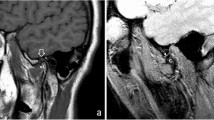Abstract
Objectives
To investigate the angulations and length of the styloid process (SP) on three-dimensional computed tomography (3D-CT) images between the patients having elongated SP complaints and those without any stylalgia symptoms.
Patients and methods
One hundred patients underwent 3D-CT evaluation of the bilateral temporomandibular joints to investigate for symptomatic elongated styloid process (ESP) at our institution. The differences between the mean angulations and lengths of the SP and comparisons between patient and control groups were analyzed by student t test.
Results
In study group, mean length of styloid processes was 40.7 ± 10.8 mm on the right and 40.3 ± 10.9 mm on the left. Mean medial angles of SP were measured as 22.60 ± 4.0 on the right side and 22.60 ± 4.5 on the left side. In the same group, mean anterior angles of SP were 16.10 ± 6.9 on the right and 16.70 ± 7.1 on the left side. The “in-group” comparisons of lengths, medial and anterior angles did not produce statistically significant results. The comparison of medial angulations between the symptomatic and asymptomatic patients was the only statistically meaningful result in our study.
Conclusion
3D-CT has several advantages according to conventional tomography for visualization of head and neck anatomy. The increase of medial angulation of SP may be responsible for the development of complaints in ESP.





Similar content being viewed by others
References
Alpoz E, Akar GC, Celik S, Govsa F, Lomcali G (2013) Prevalence and pattern of stylohyoid chain complex patterns detected by panoramic radiographs among Turkish population. Surg Radiol Anat. doi:10.1007/s00276-013-1137-x
Başekim CC, Mutlu H, Güngör A, Silit E, Pekkafali Z, Kutlay M et al (2005) Evaluation of styloid process by three-dimensional computed tomography. Eur Radiol 15:134–139
Cağlayan F, Tozoğlu U (2012) Incidental findings in the maxillofacial region detected by cone beam CT. Diagn Interv Radiol 18:159–163
Camarda J, Forest D II (1989) Stylohyoid chain ossification: a discussion of etiology. Oral Surg Oral Med Oral Pathol 67:515–520
Degirmenci B, Yılmaz O (2013) Variations of transverse foramens of cervical vertebrae: a 3-dimensional multidetector CT study. Turk J Med Sci 43:711–717
Eagle WW (1937) Elongated styloid process: report of two cases. Arch Otolaryngol 25:584–586
Kaplanoglu H, Kaplanoglu V, Toprak U, Hekimoglu B (2013) Surgical measurement of the sphenoid sinus on sagittal reformatted CT in the Turkish population. EAJM 45:7–15
Keur JJ, Campbell JP, McCarthy JF, Ralph WJ (1986) The clinical significance of the elongated styloid process. Oral Surg Oral Med Oral Pathol 61:399–404
Khandelwal S, Hada YS, Harsh A (2011) Eagle’s syndrome—a case report and review of the literature. Saudi Den J 23:211–215
Krmpotić Nemanić J, Vinter I, Ehrenfreund T, Marusić A (2009) Postnatal changes in the styloid process, vagina processus styloidei, and stylomastoid foramen in relation to the function of muscles originating from the styloid process. Surg Radiol Anat 31:343–348
Montalbetti L, Ferrandi D, Pergami P, Savoldi F (1995) Elongated styloid process and Eagle’s syndrome. Cephalalgia 15:80–93
Onbas O, Kantarci M, Murat Karasen R, Durur I, Cinar Basekim C, Alper F et al (2005) Angulation, length, and morphology of the styloid process of the temporal bone analyzed by multidetector computed tomography. Acta Radiol 46:881–886
Ozgur Z, Govsa F, Celik S, Ozgur T (2010) An unreported anatomical finding: unusual insertions of the stylohyoid and digastric muscles. Surg Radiol Anat 32:513–517
Palesy P, Murray GM, De Boever J, Klineberg I (2000) The involvement of the styloid process in head and neck pain—a preliminary study. J Oral Rehabil 27:275–287
Yavuz H, Caylakli F, Yildirim T, Ozluoglu LN (2008) Angulation of the styloid process in Eagle’s syndrome. Eur Arch Otorhinolaryngol 265:1393–1396
Yetiser S, Gerek M, Ozkaptan Y (1997) Elongated styloid process: diagnostic problems related to symptomatology. Cranio 15:236–241
Conflict of interest
The authors declare that they have no conflict of interest.
Author information
Authors and Affiliations
Corresponding author
Rights and permissions
About this article
Cite this article
Okur, A., Özkırış, M., Serin, H.İ. et al. Is there a relationship between symptoms of patients and tomographic characteristics of styloid process?. Surg Radiol Anat 36, 627–632 (2014). https://doi.org/10.1007/s00276-013-1213-2
Received:
Accepted:
Published:
Issue Date:
DOI: https://doi.org/10.1007/s00276-013-1213-2




